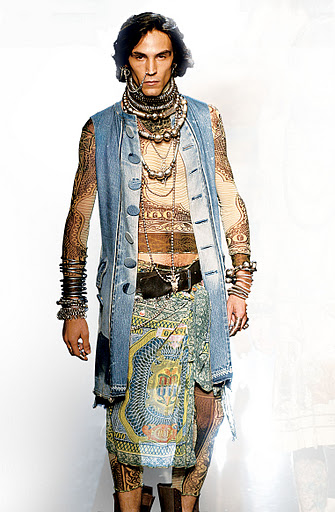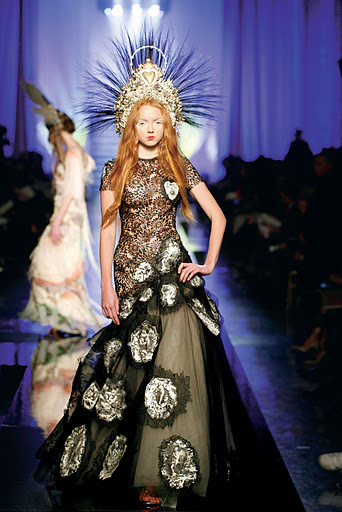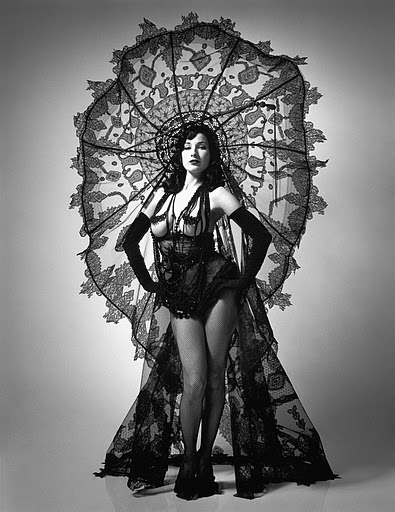BY EVENTSEEKER STAFF
The Jean Paul Gaultier retrospective at the de Young museum covers 35 years of work–that’s a lot. You feel it most acutely because the exhibition is an overload of spectacular. JPG-designed clothes in themselves would be enough: each outfit is terrifically elaborate (don’t try to figure out how many hours were spent making them or how much they cost), and supercharged with gimmicks and instantly recognizable signifiers of various cultures, subcultures, art movements, etc. But there are also moving podiums, lots of screens that show videos by Gaultier-clad pop music superstars, and mannequins that have real human faces projected on them. The mannequins smile, cry, talk, and even sing. Overall, the exhibition is a visual assault. At one point I simply zoned out.
Haute couture spring/summer 2003
Black hat-gown of lace appliqué on fine straw and
black horsehair, jet pin; black lace bloomers; black fishnet tights © Perou
Image provided by the de Young Museum
Jean-Paul Gaultier is the kind of person who can be inspired by anything. At the exhibit’s press preview, he told us a funny story about how feeding his kitty inspired him to make bracelets from empty pet food cans. You see that drive in all of the pieces in the exhibition, which abounds with paradoxes such as evening dresses made of grungy plaid shirts. Almost anything can end up as material for the new collection. I am even convinced that at the end of the day Gaultier (with his team) basically does the same thing those etsy craft ladies who make necklaces out of bottle caps do, but on a much larger scale and budget.

The Raw and the Refined collection
Men’s prêt-à-porter spring/summer 1994
30th anniversary retrospective runway show, October 2006
© Patrice Stable/Jean Paul Gaultier
Image provided by the de Young Museum
That is not to belittle Gaultier’s work as a craftsman and entertainer (and crafts/entertainment in general), but to ask a question: is he really the cultural revolutionary the hype purports him to be? The answer is both yes and no. What is most liberating in Gaultier’s output is the fashions that defy gender norms, especially strict contemporary norms of masculinity. He answered the need for unisex clothing in a highly original way, by appropriating for men the clothes that are traditionally considered feminine–corsets and, most famously, skirts. But even though he stressed his adherence to tradition (kilts, after all, have been worn by men for centuries), such fashions were considered too provocative and never found their way into the mainstream. Creating explicitly “feminine” clothes for men instead of “gender-neutral” designs is shocking because it probes into a powerful taboo. Such designs give weight to the press release‘s assertion that Gaultier’s work has a “strong social message.”

Virgins (or Madonnas) collection, “Dolorès” gown
Haute couture spring/summer 2007
Black gloss-finish guipure top over an ivory silk tulle underskirt
with large religious-motif jacquard medallion appliqués encircled by black guipure
© Patrice Stable/Jean Paul Gaultier
Image provided by the de Young Museum
On the other hand, Gaultier is no avant-gardist. He is more interested in playing with established socio-cultural codes instead of designing futuristically, for a post-gender or post-national world. From today’s perspective, his work seems firmly grounded in the ’80s and the ’90s, the age of multiculturalism, the “end of history,” and advertisements’ exhortations to “be yourself” or “express yourself.” Much has been made of Gaultier’s valuing of “individualism” and “self-expression,” his assertions that “everyone is beautiful” and “everyone is unique.” In short, he urges us to express already existing identities by plundering elements from already existing iconographies. Gaultier’s work celebrates the new sensibility which encourages delighting in cultures/subcultures/genders other than one’s own. But self-expression in this way does not lead to truly understanding the “Other.” Therefore an identity, however open and expansive, can lock onto itself. This means that Gaultier-style provocation is less troubling to hierarchical structures than stereotypes admit, and it can be easily co-opted by big money.
The Jean-Paul Gaultier exhibition will be open until August 19, 2012. It will later travel to Madrid (September 26–November 18, 2012) and Rotterdam (February 9–May 12, 2013).
RELATED LINKS
Follow us on Twitter and like us on Facebook to give us a shout. You can also stay on top of exciting events from around the world by downloading the eventseeker app for iPhone, Android or Windows.

